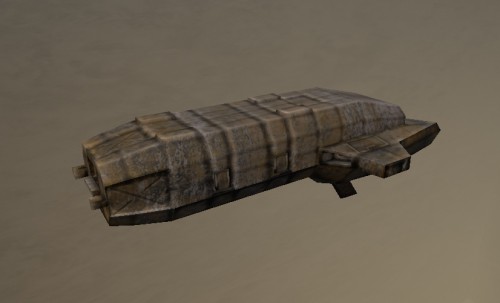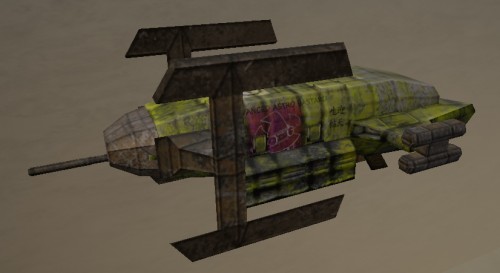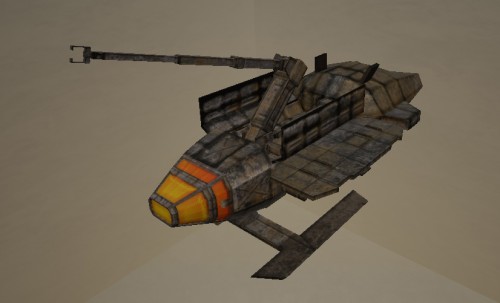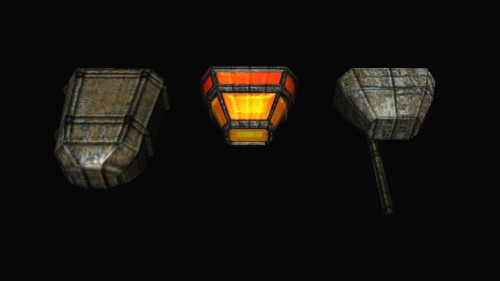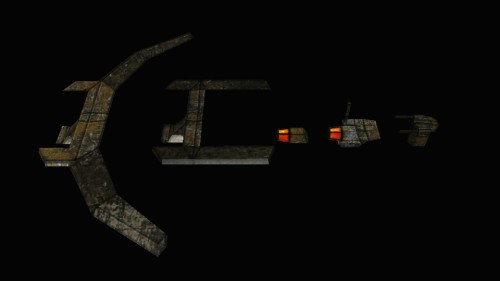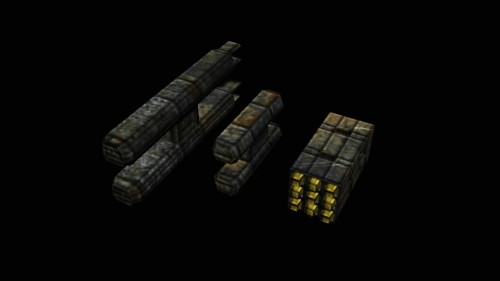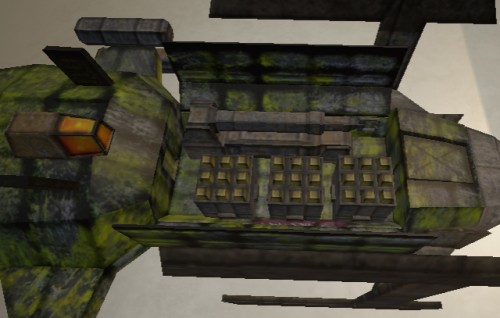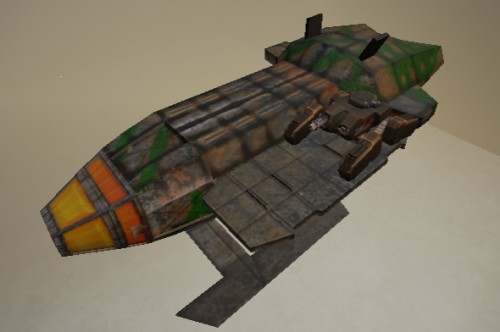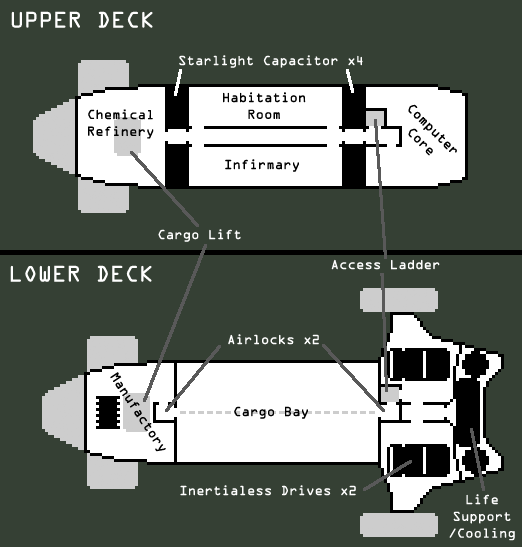Sidebar
Table of Contents
Nomad-Class Solarfoil Corvette
A small, long-ranged, and highly modular corvette hull used by many modern Freespacer cadres. Bigger than the phantasm gunship but much smaller than a gypsy class industrial vessel, the ease of modification and ability to act independently saw the class burst into widespread use practically overnight in late YE 38.
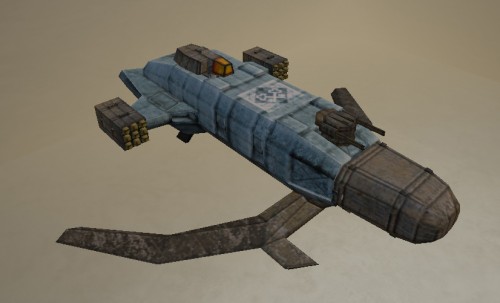 |
| The “Silent Guardian”, a Nomad gunship run by the Astral Locksmiths. |
The on-board manufacturing facilities, support for a modest crew, self-contained syntelligence system and large cargo bay are the main attractions, but many are so altered from the original design that they can be completely unrecognizable compared to another of their kin. Add to this the low cost and extremely low sensor profile, and you have a ship tempting for use even by non-spacer merchants.
Another unusual quirk is the interchangeability of the cockpit modules and the complete disregard for 'up and down' in the design. The cockpit may be mounted on the front, rear, sides or bottom, whilst the cargo bay doors might open from the 'belly' or 'back' depending on which way up the crew decided to put the hull. Some may even have multiple cockpits, whilst a scant few have none at all, being operated completely by remote control.
History
Created with inspiration taken directly from the original Skeleton Ensemble corvette, itself salvaged from a burned-out empty hull, the Nomad Solarfoil could be said to have dozens of creators spanning across several decades. It was Antibody Hollowpoint Five Seven 57 8449-2815 who first recorded the design with the intent of copying it on mass, after encountering the plucky vessel and her crew briefly at Port Hope. The original intention was to simply provide the Viridian Array with a ship hull they could provide to those spacers who wanted to defect independently from their motherships, but mutated into extended use by all sorts of new sub-factions once the design hit the polysentience.
Welcomed by those that saw the old Free State as a hideous form of vast hypocrisy, it is now the favored ship class of inter-nation merchants, miners, hired technicians and even start-up mercenaries. New modules are being produced every day and distributed over the polysentience, insuring that supporters will have a wide range of new equipment options that only expands over time.
Statistics and Performance
Base Hull Cost (Without Modifications): 14,000 KS
Organizations Using This Vessel: Freespacer Cadres, Various Polysentience Users Type: Modifiable Long-Range Stealth Transport Craft Hull Materials: Durandium, mixed steel, aluminium and titanium, some boron and tungsten superstructure Designer: Antibody Hollowpoint Five Seven 57 8449-2815, Polysentience, Intelligent Design Node, Individual Crew Members Manufacturer: Freespacer Cadres, Various Polysentience Users Production: 100< Crew: Max Between Eight and Twelve Freespacers; Can Operate Autonomously If Required
Base Hull Data
Length: 46< meters Width: 14< meters Height: 9< meters Decks: 2< Mass: 220< Tonnes
Damage Capacity
Hull: Tier 8 Shields: Bubble-Type Barrier.
Propulsion And Range
Propulsion Type: Inertialess Drive System x2 Power Source: Starlight Cells x4
STL Speed (Maximum Recommended): 0.42c Acceleration (STL) In Stellar Red Zone: 0 to Max in 2 seconds Acceleration (STL) In Stellar Habitable Zone: 0 to Max in 8 seconds Acceleration (STL) In Stellar Blue Zone: 0 to Max in 20 seconds
FTL Speed (Continuum Distortion Field): 0.18 ly/m Range: Six months assuming eight crew or less, though it's theoretically infinite if water, sulfur and metal ore for replacement parts are acquired on site.
Other Example Vessels
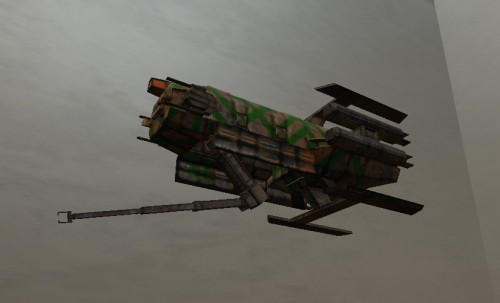 |
| The “Reckless Abaddon”, a Nomad salvage/subterfuge ship crewed by the Viridian Array. |
Common Equipment Modules
Dorsal Hardpoint Options (Can mount only one.)
| Module Name | Summary | Price |
|---|---|---|
| Cargo Pod | Allows 50% extra cargo space, or living space for 4 extra crew members. | 1,400 KS |
| Large Cockpit | Twin seat deluxe cockpit with an excellent panoramic view port. No radar or communications abilities. | 1,600 KS |
| Long-Range Antenna Pod | An Entropy's Shroud Electronic Warfare Suite advanced ECM suite, which also allows the craft to act as a miniature polysentience relay. Excellent radar and communications abilities. | 6,500 KS |
Side, Top and Bottom Hardpoints (Can mount up to six.)
| Module Name | Summary | Price |
|---|---|---|
| Prism Shield Sail Type 'C' | Large speed-focused energy absorbing 'wings'. Gifts a 20% increase in acceleration. | 4,000 KS |
| Prism Shield Sail Type 'H' | Large defence-focused energy absorbing 'wings'. Gifts a +1 point to defence tier. | 4,000 KS |
| Small Cockpit | The cheapest and most basic single pilot den. Just a glass box with a seat and a joystick, no frills. | 800 KS |
| Improved Cockpit | A slightly better cockpit with a basic radar imaging and communications system. | 1,200 KS |
| Warding Rune Defense Turret | Rapid-fire quad autocannons useful against missiles and power armor. Sometimes taken in numbers and used offensively, battering the enemy with in sheer weight of fire. | 2,000 KS |
| Pseudoflare Artillery Gun1) | A heavy solid-round cannon with radioactive explosive shells. Fixed facing forwards. | 3,000 KS |
| Starjammer Laser Turret2) | A highly adaptable multi-spectral anti-ship laser. Can fire at any angle, but consumes large quantities of power to use effectively. | 3,000 KS |
Engine Pylon Hardpoints (Can only be taken as a pair.)
| Module Name | Summary | Price |
|---|---|---|
| Chemical Booster Rocket | Increases speed by an extra 40% for five minutes. | 2,000 KS |
| External Battery | Two extra Starlight Cells. Increases power reserves by 50%. | 3,500 KS |
| Multi-"Baby Nuke" Missile Pod | Nine miniature nuclear missiles each, that can be fired in rapid succession. | 6,500 KS |
Cargo Bay Utilities (Can take up to two.)
| Module Name | Summary | Price |
|---|---|---|
| Folding Crane Arm | Used to grab salvage, anchor the ship, or sometimes puncture enemy hulls. | 1,100 KS |
| Traveller Shuttle | The traditional one-man interstellar vessel. | 4,000 KS |
| 3 x Multi-"Baby Nuke" Missile Pod | Turns the vessel into a 'Q Ship' that can surprise enemies. The missiles are fixed facing downwards, however. | 12,000 KS |
| Deathcrawler Auto-Tank | A large, heavily armed and armored junker, that can be used as an additional 'instant turret' if needs be. | 7,000 KS |
Special Modifications
| Module Name | Summary | Price |
|---|---|---|
| Landing Deck | Can take two extra cargo bay utilities, or allow docking with two more small craft externally. An integrated airlock module connects directly onto the side of the ship for ease of access. | 1,200 KS |
| Actual Safety Procedures | An internal modification that seals up the reactor and fabrication rooms better, making it safer for non-spacers to walk around unsuited. | 800 KS |
| The Planetwalker Scumbag's Option | The entire hull is reinforced and small wheeled legs added to the cargo bay doors, allowing the vessel to actually land on planets. | 1200 KS |
Inside the Ship
Much like the exterior, the insides of no two Nomads are ever quite the same. Generally speaking, however, they tend to have very little in the way of creature comforts and habitation fittings, making the entire interior a mess of grey bare metal panels and brown support girders, plus various coolant pipes and cables. Small, cramped, dimly lit and charmingly makeshift is generally the rule of thumb.
Some are filled with little but rampant industrial contaminants and radiation-eating lichen, whilst others are majestic and quaint treasure troves of ancient talismans and religious trinkets. It very much depends on the personality of the crew, the line of business, and/or the fleet that the ship is attached to. A Nepleslian or the like is still better off staying inside their space suit regardless, unless it has been specifically treated and modified to be safe for them to board. One can expect to find the corridors completely packed with whatever the team sees as their personal business, be it mineral ore, spare parts, or knee-deep piles of exotic ammunition.
Fire suppression systems are rare, with the crew often simply closing off the airtight bulkheads around the effected area. Sometimes a handheld Fire Extinguisher 🧯 or some hull repair putty is kept somewhere on board. Keeping the crew warm depends on reactor heat running through the coolant lines, meaning it can also get fatally cold if the ship is operating stealthily in low-power mode for too long.
Both internal and external cameras are rare, sometimes with the crew even eyeballing the basic navigation of the vessel. Fortunately, all spacers are cyborgs, making this rarely a serious problem. Three or four junker drones may be used as an ad-hoc security crew as well as their normal repair duties.
Chemical Refinery
The upper nose cone section is occupied by a large chemical refinery system. Accomplished using miniature gravity-drive assisted distillation and electrolysis devices depending on the material in question, it can process many forms of ore and gasses into useful chemicals, such as oxygen for life support, sulfur for use in the ship's food processing system, and metals for use in the manufacturing room. As well as pipes leading directly to these systems, there are also four large pressure sealed caskets that can store either liquids or gasses, and an small elevator system for transporting said containers to and from the manufacturing room.
The two side walls are often fitted with a CASS racks, useful for keeping violet chemicals from exploding… But frequently used in their original role of ammunition storage, too. The dorsal, upper front, and side front hardpoints can all be accessed from here, making them pretty good locations to mount turrets.
Central Corridor
A single narrow corridor that spans the entire middle upper level of the fuselage. Both ends have constantly humming starlight cell capacitors built directly into the walls. There is direct access to the forward chemical refinery, port habitation and starboard infirmary rooms, as well as the rear computer room. A ladder-shaft near the aft, next to the computer room door, gives access to the cargo bay, both engine rooms, the life support room, and whatever is connected to the upper and lower rear hardpoints (Generally a cockpit).
Habitation Room
A series of eight combo sleepingbag-hammocks are attached to the walls in four columns of two. The long and thin room is somewhat spacious, but is almost always filled to the brim with personnel supplies, including food, entertainment, trade items, spare voidsuit components, and general survivalist gear. There is a temperamental miniature combination electric cooker / microwave oven on the aft-most corner, free for anyone to use, but in lieu of a fridge, perishable food is often simply left in the cargo bay where it is cold anyway.
Infirmary
A mirror image of the habitation room in terms of shape, but a large portion is taken up by an automatic cybermedical table with several robotic arms that the ship's healer is intended to directly interface with. Much like the manufacturing room there are many cabinets filled with random medical tools of various ages and states of repair. There is also a person-sized sterilization / quarantine tank, which is also the only shower on the vessel. The forward wall also contains a small 1 x 1 meter air sealed chamber with a toilet, which is piped directly to the chemical refinery for breaking down.
Computer Core
The rearmost room on the upper level contains the main computer systems, including navigation, communication, polysentience processing, prism-shield system dynamics, inertialess drive control, sensory configuration, and the syntelligence's main processor banks. It can actually get dangerously hot when complex calculations are being performed, even though it is water cooled.
Manufacturing Room
The lower-front room in front of the cargo bay is a large fabrication center, containing everything the vessel needs to completely rework itself, and any cyborg crew members on board. There are many, many random tool items strewn around the floor and hooked up to the walls, in various stages of disrepair.
The left of the room contains a formidable high-power furnace that channels heat safely down through an independent cooling system, directly connected to the the prism-shield sails below, and the right side of the room contains a multi-armed automatic assembly bench with all manner of moldings and assembly tools. Directly at the center of the ceiling is the access lift to the chemical refinery, and the rearmost wall allows access to the airlock that leads to the cargo bay. About four junker drones are typically seen recharging here, prone to being used as stools, since there are no seats.
Note that using all of these components matched with the chemical refinery, the ship effectively has a working grinder on board, through certain parts of the process may need more manual interaction than normal.
Cargo Bay
The largest single room in the vessel, the gravity is generally turned upside down in here, due to the fact that the entire compartment can open up using a huge pair of access doors that cover almost half the underside of the vessel. There are airlocks in both the front and rear, which are the primary methods of accessing the interior of the vessel.
There is about 24 x 10 meters of cargo space. Items are typically left to be secured by gravity alone, but can be chained down to integrated loops in the floor panels given enough time and effort.
Life Support / Food Processing System
This central-rearward compartment on the bottom floor is dominated by a huge aquarium, and all sorts of water filtration and ventilation devices. The water tank is constantly being supplied with sulfur-enriched hot air from the engines, replicating the exact environment of a seabed hydrothermal vent, crustacean-based ecosystem and all. Rather than conventionally farmed hydroponic plants, this is a constant source of protein-rich sustenance for crew (!). It can also produce large quantities of edible algae, but typically this is used to feed the crabs unless they are running low.
Inertialess Drive Engine Rooms
The vessel contains two large rooms on the lower deck, bulging out noticeably from the rear of the ship. These both contain a separate Inertialess Drive engine, used in tandem to produce an impressive overall output. They can be repaired whilst operating even inside the vessel, or operate independently if the other engine is completely out of commission.
Ship Systems
Important Note; This vessel is not designed to work on planets with atmospheres. It can physically fly inside of them, and even hover reliably using it's gravity-manipulating drive system, but has zero ability to actually land. The fragile power management systems are all on the belly…
Inertialess Drive
The same basic propulsion system as the regular Phantasm, only massively scaled up, it can motivate the entire vessel by changing it's mass relative to other objects, giving it superior agility when close to large astronomical bodies.
The downside, however, is that this antigravity effect requires more and more energy the further the vessel is from said objects, and thus the effect diminishes the greater distances the vessel is away from a suitable power source or a large object to “push off” from.
It can also double as an FTL engine by generating continuum distortions, but understandably this cannot be recharged unless jumping directly into another suitable star system radius. This makes efficient power management and guidance from a dedicated stellar navigator practically mandatory.
Prism Shield-Sails
There are several versions of this system that may be chosen, but they always look like strange 'wings' or 'sails' attached to the outside of the craft.They vastly increase the vessel's ability to absorb magnetic fields and stellar energy for its own use. It can also absorb energy attacks somewhat, adding their power directly to the vessel's starlight cell clusters.
When running in low-power “quiet mode”, they can also be used to manipulate ambient energy levels to disguise the vessel as another vessel or random debris, giving it a somewhat chameleonic effect. In combat, it functions as standard shielding of a low-to-average quality level.
Starlight Cells
Effectively solar powered, these vessels use the standard Freespacer composite voltaic cells to power it, contained chiefly in the belly of the ship, surrounding to two inertialess drive engines. They are recharged continuously by the shield-sails whenever the vessel is in the vicinity of a star, or even a large gas giant.
Despite a somewhat increased independence technically speaking, all of the power systems still require direct sunlight to be recharged. Operating in the shadow of a planet is not a good idea unless significant inertia is built up beforehand.
Starlight Capacitors
The energy harvested from the starlight cells are stored in four very high density capacitor banks located around the middle of the vessel. At full charge power reserves last for 96 hours of low-intensity shield use (passive sailing or running silent), or alternatively 30 minutes of high-intensity shield and propulsion use (combat mode).
Hyperspace jumps require at least two-thirds of a full capacitor charge. In high orbit around a star's corona, a full capacitor recharge takes only two hours. Sometimes, an extra pair of capacitors are mounted on the two wing pylons, increasing the ship's available power reserves by half.
Savant Computers
The entire computer system and networked junker system is controlled by a single Synthetic Intelligence. This program can operate the vessel entirely independently, including any turrets or crane-arms, but their ability to self-repair and self-regulate is massively diminished in lack of an organic crew. The external cameras are also extremely lackluster, meaning the Syntelligence will often request direct visual feeds from cyborgized crew members.
Evanescent Wave Coupler
The standard means of FTL communication by the Freespacers, allowing the transfer of huge quantities over long distances or the coordination of fleet maneuvers. This system is backed up by secondary radio and laser communication systems. May also be used to sap energy from compatible wireless energy transmitters, meaning these units have effectively unlimited energy assuming there are enough support vessels in proximity to power them.
This system tends to be extremely limited in range and functionality when sticking with the base design, but the addition of a transmission mast is capable of increasing the effectiveness to extremely high levels given the massive amount of computer systems on board.
Heat Radiation System
Because the vessel creates a great deal more heat than the Phantasm, it requires the two heat radiation panels sticking out of the rear belly of the ship, in order to keep it's heat levels in check. They can be turned off in order to activate a sort of “stealth mode”, but internal heat levels will build up to catastrophic levels in as little as thirty minutes if the ship is operating at full speed with its shield up.
If this system is damaged, it is imperative that the cargo bay doors are left open at the very least.
OOC Notes
Primitive Polygon created this article on 2016/11/19 08:08. Modified on 2017/28/04 17:24 to fit in with version 3 of the damage system.
Page Tools
Terms of Service - Privacy Policy

